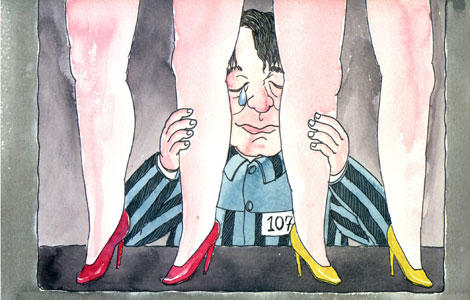Economic restructuring helps China's growth
Updated: 2013-07-23 17:41
By Hao Yan (chinadaily.com.cn)
|
|||||||||||
China's year-on-year GDP growth eased to 7.5 percent in the second quarter, while the first half witnesses an overall 7.6 percent growth. It was not as bad as some experts predicted as the country is undergoing economic restructuring.
This quarter's 7.5 percent GDP growth rate has just hit the annual target. The Chinese central government in March has announced its 7.5 percent GDP growth target this year, the same as that of 2012. Premier Li said in March that the country needs a substantial and effective development rather than an 8 percent GDP growth.
This quarter is obviously not the toughest quarter, but business-as-usual. China saw its GDP growth drop in eight consecutive quarters from the fourth quarter in 2010. The country's economic growth hit the bottom in the third quarter in 2012 to 7.4 percent year-on-year, and rebound in the last quarter.
China's growth model used to base on export and heavy investment. However the global economic situation has changed violently in the past six years. Economic drawback was frequently witnessed in many developed countries. Some countries implement loose monetary policies and Quantitative Ease to stimulate their economy. Some countries employ trade barriers to block imports and protect domestic manufacturers. All of these have brought strong impact to the Chinese economy during the largest ever global economic recession since the World War II.
China, responsible for the economy of the world and its own nation, seek development from its inner potentials through economic restructuring, transformation and upgrading. Chinese government did not adopt a loose monetary policy which may end up with rocketing inflation. Chinese government did not employ trade barriers which may cause trade wars, though some actions were made on certain imported goods only if anti-dumping duties were unreasonably levied on Chinese exports.
When China continues to reform its economic structure, it is necessary to face the possibility that growth could dip during a period of time, so as to reduce the dependence on investment and global market demand and squeeze financial risks.
China's financial reform has just made a milestone move on July 19 that the central bank removed controls on the lending interest rates of commercial banks. The country now makes the allocation of financial resources more efficient, and providing long-term, sustained traction for its economic growth.
This move was one month after a State Council executive meeting deployed eight financial policy measures supporting economic restructuring, transformation and upgrading.
The eight policy measures also guides credit funds to support the real economy, increases credit tilt towards the "agriculture industry, rural area and farmers" and small- and micro-enterprise, and boosts consumer upgrades and promote private capital.
These policies can be regarded as concrete guidance in accordance to the 12th Five-year Plan, as they will benefit China's real economy and help promote sustainable growth in the long term. Despite some countries' leaders are eager to win a favor over their own problems by blocking Chinese private companies.
Now, China needs to create high productivity and highly value-added growth, which represent opportunities and possibilities for competitions in the future. Chinese enterprises are transforming and upgrading themselves towards the future, and abandon the low value-added obsolete production methods.
China has resources to cope with the economic slowdown, said former World Bank president Robert Zoellick in July 2012.
"I think China will likely be an ongoing source of growth. The potential crises I see are elsewhere," Zoellick said in February the same year.
Related Stories
Beijing GDP rises 7.7% in first half 2013-07-18 17:38
China's GDP growth slows in 2nd quarter 2013-07-15 16:14
China's Q2 GDP growth slows to 7.5% 2013-07-15 10:24
China will see softlanding: Zoellick 2012-07-31 10:13
Move to free up interest rate 'symbolic' 2013-07-23 10:29
Freeing bank lending rates a critical step 2013-07-22 13:43
Today's Top News
UK, Ireland join forces to lure more Chinese visitors
Chinese police question employee of AstraZeneca
Quake in NW China kills 89, injures 700
Kate gives birth to a baby boy
New visas to boost family reunions
Huawei launches mobile app contest in EU
China to implement stricter air quality controls
China's FX purchases decline
Hot Topics
Lunar probe , China growth forecasts, Emission rules get tougher, China seen through 'colored lens', International board,
Editor's Picks

|

|

|

|

|

|





